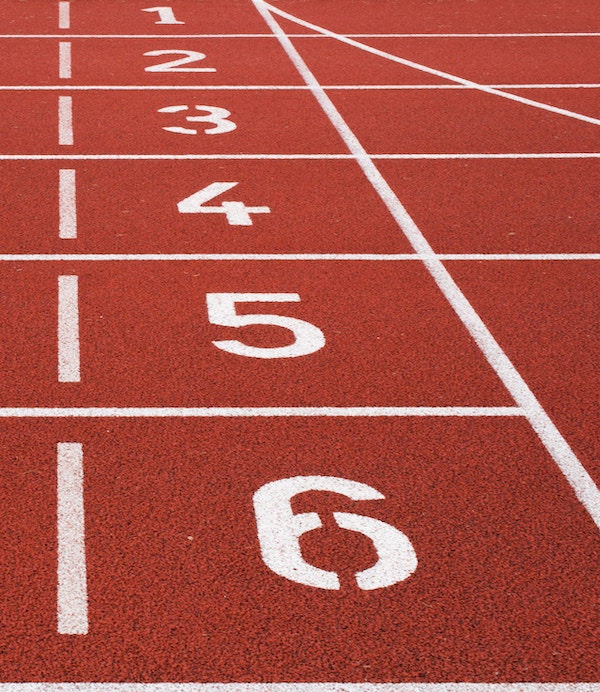
There's a problem with the narrative around athletes and pay. Although big contracts make the news and we call rewarded athletes "overpaid", there is an army of athletes who will never touch those eye-popping salaries. As a whole, we contend, athletes are underpaid.
Frédéric Bastiat wrote in his famous essay What is Seen and What is Not Seen, "Let us accustom ourselves, then, not to judge things solely by what is seen, but rather by what is not seen."
Most Athletes Never Go Professional
Starting with Pee Wee sports, there is a reasonably well defined route to major professional leagues.
Kids as young as 4 or 5 learn sport fundamentals and play for school sports teams and in pickup games in their neighborhoods. As they grow up, there are sports camps, AAU teams, college camps, and other competitive travel teams which put young athletes onto scouting radars.
Once scouts are paying attention, the next step is usually (with the notable exception of baseball) recruitment to an NCAA school. Most athletes will attempt to play for Division I-A schools (football) or Major Conference teams (basketball) if they dream of a pro sports career. Professional teams draft very few players after college is over. Even fewer will sign the huge contracts dismissed as absurd and obscene.
The odds are so stacked against being an "Athlete" as a career a few absurd contracts is the name of the game. For all the millions of children who grew up dreaming they'd be the next Michael Jordan, Emmitt Smith, Babe Ruth, Wayne Gretzky, or Pelé, almost zero will come close.
Sunk time and cost for athletes
It's a bias against the unseen - there has to be a reasonable reward at the end of the road for athletes that actually make it out of the various stages of athleticism.
There are cuts at every stage – it's an incredibly hard pyramid to climb. While there are millions of young athletes, there are far fewer high school athletes. Even more cuts happen at the college and professional level.
And at every level of cuts, there was more sunk time and money for an athlete to reach that level.
How Many Athletes are There in the United States?
How large is the professional athlete draft pool? In 2006, CNN pegged youth participation at around 41 million. Athletes in the NCAA number over 450,000.
There are more than 450,000 NCAA athletes. Most won't play professional sports.
Now, let's look at the four major sports:
Football (NFL): 32 players a round * 7 rounds means 224 players a year from the draft, plus a smattering of Free Agents - generally place kickers, punters, and the occasional retiree. Rosters are 53 players plus up to a 5 man practice team, leaving between 1,696 and 1,856 professional players in the NFL.
Basketball (NBA): 30 players a round * 2 rounds means 60 players a year in the draft. NBA rosters are usually around 12 - 15 players. There are between 360 and 450 players in the NBA.
Baseball (MLB): Baseball is the big exception to our draft rule, due to its varied league levels and development teams (Low-A, High-A, AA, AAA, Majors). There's no hard draft size, but in 2006 1,503 players were selected. (Many never made a major league roster.) MLB has 25 on active rosters and a 40 man roster (and 30 teams). Depending on your count there are 750 - 1,200 players in the majors at a time.
Hockey (NHL): 30 players a round * 7 rounds means 210 players a year in the draft. Hockey has a lively minor league, but major league rosters number only 23 players. There are only ~690 players at any one time on major league rosters.
Add that up: there are roughly 3,500 to 4,200 professional players in the four major American sports leagues.
Athletes are Underpaid and Minimum Salaries are Relatively Low
We pulled minimum salaries for the four major leagues for the 2018-2019 seasons.
The NHL comes in with a minimum salary of $700,000. Basketball players pull in an entry (2017-2018) $815,615 annually. The minimum in Baseball is $545,000. Football players make at least $480,000 annually (and $7,200 weekly for players on the practice squads).
Those numbers are huge - the 2010 median household income in the United States was $49,445.
Career Longevity: Forced Retirement in Your 20s
Of course, when talking about career longevity people tend to cherry pick the most durable player:
- Robert Parish (21 seasons, NBA)
- Brett Favre (20 seasons, NFL)
- Wayne Gretzky (16 seasons, NHL)
- Tim Wakefield (17 seasons, MLB)
The truth is most players will see no where near the longevity nor the contracts we see from the Peyton Mannings and the Alex Rodriguezes of the world. Most players will be closer to the minimum, and play out much shorter careers.
From what we can find, NHL players average 5.66 seasons, NFL players 6.86, NBA players 4.81, and MLB players (again, skewed by minor leagues) 5.6.
These numbers are also averages since median numbers are hard to find (but obviously medians will be less than averages). To give a hint to variability, the NBA study linked gives 4.81 as an average career but a standard deviation of 3.69. In other words, 68% of NBA athletes have career lengths between 1.12 and 8.5 seasons.
Remember, a college athlete drafted at 21 and out of the league 5 years later is 26 years old. Even with 5 years of large salaries, their future is not guaranteed. It's one of the reasons so many former players are broke, even many who earned salaries near the top of all players.
The Devastating Effect of Injuries on Young Athletes
In hockey, there are multiple junior leagues plus a waiver in the draft to allow teams to select professional athletes. In baseball, there are essentially two ways to get into the big leagues (outside of playing somewhere like Puerto Rico) - play in college, or get onto a low-A team in somewhere like the Cape Cod League.
Salaries are lower for many of these minor league teams, but they exist, unlike for the "minor leagues" in football and basketball. Football and basketball have historically been lucrative for colleges, had the most booster and recruiter involvement... and the most scandals.
One major factor in this is the NCAA's de facto monopoly on student athlete talent - the NBA has a minimum draft age of 19 years old, while NFL athletes must be at least 3 years post-high school. The leagues definitely benefit from this monopoly on young elite player talent.
While there is an NBA D-league, there is no need for a minor league in the NFL. Does the NCAA benefit? Of course they do. Member schools can hand out scholarships, which at face value are worth $30,000-$60,000... but realistically, many athletes are not going to school for a degree.
Anecdotally, many athletes end up with degrees in University Studies. For every Rhodes Scholar, there will be many athletes who never even complete a degree. The school makes money from football and basketball programs, the NCAA makes money from member dues, and the athlete winds up with a degree he or she probably didn't set out to earn.
Who is hurt the most? The players, who possibly are sitting on a lottery ticket with a fast-approaching expiration date: their athletic careers.
A Bigger Scandal than Recruiting Scandals: Athlete Injury Risk
None of that excuses the scandals that plague the two glamour sports. It does, however, go a very long way towards explaining them.
Scandals from USC to Oregon to Auburn to Ohio State to Miami can be traced back to a simple problem: there is a huge risk of injury when playing sports. That injury risk, especially in football, prevents many athletes from ever making the money they could have made.
For every Reggie Bush, who makes a deal to cash in on potentially fleeting talent during a college career, there is someone like Jason White. Jason White's sports story is especially tragic: he won a Heisman (and nearly two!) but knee injuries meant he never contributed in the NFL.
The world will remember Reggie Bush as the first ever ex-Heisman winner. Someone will remember Jason White's incredible college career during a trivia game in a sports bar
From Cam Newton to Charles Barkley, there is a generation of players – those we know about and those we don't – that thought through these risks. Sure, basketball's looser age restrictions may have prevented scandals as devastating as football's, but there are certainly many in basketball to choose from.
Special Talents and Forced Amateurism

History abounds with examples of 'special talents' painted with the claim they'd only succeed in college. That might lead to some athletes pocketing booster money, but even athletes who believe they'll "go pro" aren't immune. The injury risks are too great and taking some money might seem reasonable insurance against a career ending injury.
That's the effect of forced amateurism. Even 'destined' athletes "pay their dues" in college before they can enter the draft.
The NFL average career of 6.86 years may seem great at first glance. However, once you factor in the injury risk of playing in college and high school things look quite a bit different.
Players who try to take the legal way out of forced amateurism – Maurice Clarett, Mike Williams, Terrelle Pryor – were forced to skip draft dates. They also undoubtedly signed smaller contracts than if they 'made it' to the draft uninjured.
Athletes are Underpaid: Summing it all Up
The next time you hear that athletes are overpaid, think back to this article.
Some of the contracts in the sports world will always grate on the public's nerves. Keep in mind though: salaries are high but rational - in aggregate, athletes are underpaid.
Consider the difficulty of this sequence:
- Develop the skills necessary to be a professional
- Stay injury-free until you can demonstrate those skills at the Pro level
- Maintain those skills for a reasonable number of years
The next time you hear someone complaining about sports contracts remember the special talents that never made it. For every huge contract, many near anonymous journeyman players make the league minimum. Further, many college stars never even cashed in on their elite skills .
In the immortal paraphrased words of Bastiat, remember the unseen underpaid players.

